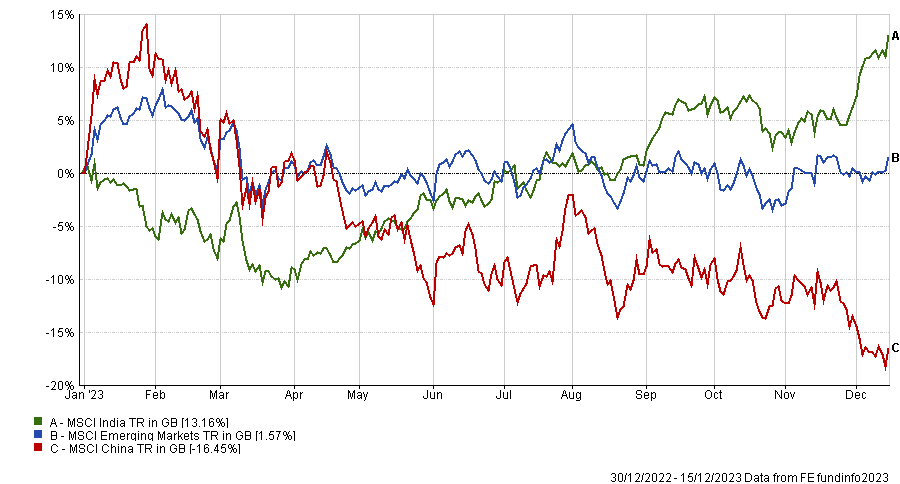A resurgence in growth investing, the rise of artificial intelligence and the drastic underperformance of China are among the investment trends that dominated markets in 2023.
In a review of the events of the past year, Hargreaves Lansdown senior investment analyst Joseph Hill picked out some of the biggest market moves and offered some insight into what might happen next.
Growth trounces value
The growth style of investing, which looks for companies expected to grow at an above-average rate compared to the market, dominated the decade-long bull run following the global financial crisis. However, its streak was broken in 2022 when rising interest rates caused investors to turn to cheaper value stocks.
But Hill pointed out that growth investing returned to the fore in 2023 as investors started to price-in the end of interest rate hikes. FE Analytics shows that the MSCI World Growth index has gained 28% over the year to date while its value counterpart is up little more than 4%.
Performance of indices in 2023

Source: FE Analytics
Looking forward, the Hargreaves Lansdown analyst added: “Putting the debate around ‘how high for how long’ to one side, when rates do come down that is likely to benefit share prices and particularly those companies with lots of growth potential.
“This performance profile serves as a reminder to investors of the benefits of diversification. And not just by geography, but by style. Those sitting back admiring a strong year for their growth-focused portfolio or lamenting a token return from their value-biased investments might want to revisit the weighing scales.”
The Magnificent Seven and AI drive the US market
The US market has enjoyed another strong year, with the S&P 500 rising 17.7% (in sterling terms) over 2023 so far. Hill pointed out that the bulk of this gain came from the “stellar performance” of the so-called Magnificent Seven: Nvidia, Meta, Tesla, Amazon, Google, Apple and Microsoft.
Performance of indices in 2023

Source: FE Analytics
“Investors have grown excited about the potential and the reach of artificial intelligence, so stocks with exposure to this dominant theme have soared,” he said.
“The performance of these stocks has contributed to an increasing concentration of the US market in these companies after a more underwhelming year for the rest of the index.”
On the back of this, IA Technology & Technology Innovation has been the best performing fund sector this year with its average member making a 36.7% total return.
India prospers and China flops
Emerging markets faced a tougher year than the developed world: the MSCI Emerging Markets index rising just 1.6% versus a 15.6% gain in the developed markets-focused MSCI World.
But, as the chart below shows, there was some clear divergence in the fortunes of individual emerging markets with the Indian stock market outpacing China by a significant margin.
Performance of indices in 2023

Source: FE Analytics
Hill said that the strong Indian economy has “taken centre stage” for those investing in Asia and emerging markets. The country’s small- and mid-caps, along with companies geared to the domestic economy (such as financial services and consumer stocks), have performed especially well.
“While pricier than its regional peers, India offers an array of advantages, including improved corporate governance standards, favourable demographics and growing foreign direct investment. India's economy is also expected to surpass both Germany and Japan by 2028, making it the third largest globally,” he added.
The average IA India/Indian Subcontinent fund has made a 16.1% total return in 2023 so far, ranking it as the third best of the Investment Association’s 56 sectors. This is in stark contrast to IA China/Greater China, which is the year’s worst performer with a 21.4% loss.
Investor sentiment towards China took a hit when the country’s Covid-reopening story proved to be a flop. Hill also noted that Chinese equities have been held back by a weaker consumer, headwinds in the property sector and the ‘re-shoring’ trend (where other countries move production closer to home) cast doubts over future growth.
But he added: “Investors may be thinking about rebalancing their Asian exposure. Chinese valuations at 20-year lows is a good measure of where sentiment is today. This suggests that there could be opportunities for investors willing to look through the gloom to the long term.”





